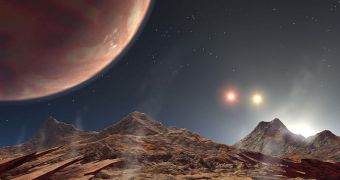Rather than trying so hard to discover Earth-analogs among the thousands of proposed extrasolar planets telescopes are bound to discover, astrobiologists should focus their efforts on extrasolar moons, which may be primed candidate locations to allow for the existence of life.
Exomoons can be found in orbit around exoplanets, but they are extremely difficult to identify with existing technology. This limitation is due to the relatively low performances of existing telescope, but also to the massive distance involved.
Exoplanets are currently detected either by analyzing a star's wobble to see if a planet is pulling on it, or by checking for variations in a parent star's brightness. The latter may be an indication that a planet passed between the star and our vantage point here on Earth.
As such, detecting whether the identified exoplanets have exomoons is even more difficult. But experts in astrobiology say that the best bet to find a world that is capable of supporting life as we know it is to look for exomoons around gas giants such as Neptune.
These planets also need to be located in the correct orbit around a Sun-like stars, which drastically narrows down the range of potential candidates. However, NASA's planet-hunting telescope, Kepler, is only beginning its journey.
At this point, astronomers have confirmed the existence of more than 560 exoplanets, and Kepler's data – still awaiting confirmation – indicate the existence of an additional 1,235 candidates. Other telescope capable of detecting such objects are scheduled to launch soon.
“The satellites of extrasolar planets have been recently proposed as astrobiological targets. Since giant planets in the habitable zone are thought to have migrated there. It is possible that they may have captured a former terrestrial planet or planetesimal,” says Simon Porter.
The expert holds an appointment at the Lowell Observatory. He conducted the work with expert William Grundy, who is based at the Arizona State University (ASU), Universe Today reports.
“We therefore attempt to model the dynamical evolution of a terrestrial planet captured into orbit around a giant planet in the habitable zone of a star.” the two add in an interview for Universe Today.
“We find that approximately half of loose elliptical orbits result in stable circular orbits over timescales of less than a few million years. We also find that those orbits are mostly low-inclination, but have no prograde/retrograde preference,” they add, quoted by Daily Galaxy.
“In addition, we calculate the transit timing and duration variations for the resulting systems, and find that potentially habitable Earth-mass exomoons should be detectable.” the two astrobiologists conclude.

 14 DAY TRIAL //
14 DAY TRIAL //